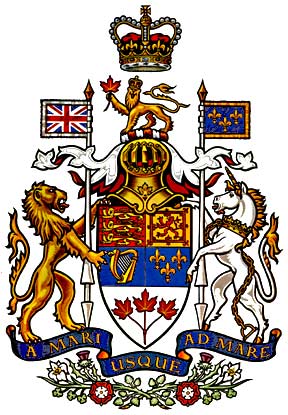This is a list of the symbols of the provinces and territories of Canada. Each province and territory has a unique set of official symbols. [1]

Canada has ten provinces and three territories that are sub-national administrative divisions under the jurisdiction of the Canadian Constitution. In the 1867 Canadian Confederation, three provinces of British North America—New Brunswick, Nova Scotia, and the Province of Canada —united to form a federation, becoming a fully independent country over the next century. Over its history, Canada's international borders have changed several times as it has added territories and provinces, making it the world's second-largest country by area.
The Canadian order of precedence is a nominal and symbolic hierarchy of important positions within the governing institutions of Canada. It has no legal standing, but is used to dictate ceremonial protocol.
There have been various movements within Canada for secession.

Regional tartans of Canada are represented by all Canada's provinces and territories having a regional tartan, as do many other regional divisions in Canada. Tartans were first brought to Canada by Scottish settlers; the first province to adopt one officially was Nova Scotia in 1956, and the most recent province was Ontario, in 2000. Except for the tartan of Quebec, all of the provincial and territorial tartans are officially recognized and registered in the books of the Court of the Lord Lyon, King of Arms of Scotland.
This is a list of the legislative assemblies of Canada's provinces and territories. Each province's legislative assembly, along with the province's lieutenant governor, form the province's legislature. Historically, several provinces had bicameral legislatures, but they all eventually dissolved their upper house or merged it with their lower house, so that all provincial legislatures are now unicameral.
The orders, decorations, and medals of the Canadian provinces, in which each province of Canada has devised a system of orders and other awards to honour residents for actions or deeds that benefit their local community or province, are in turn subsumed within the Canadian honours system. Each province sets its own rules and criteria for eligibility and also for how each award is presented. Most of the awards allow for the recipients to wear their awards in public, and most grant the recipients the use of post-nominal letters after their names. Not all of the awards listed below are part of the Canadian honours system, thus some of them may not be worn or court mounted with awards that are part of the Canadian honours system.

Canada is divided into six time zones. Most areas of the country's provinces and territories operate on standard time from the first Sunday in November to the second Sunday in March and daylight saving time the rest of the year.
This is a list of elections in Canada in 2006. Included are provincial, municipal and federal elections, by-elections on any level, referendums, and party leadership races at any level. [Cite source to verify information]
The timeline of elections in Canada covers all the provincial, territorial and federal elections from when each province was joined Confederation through to the present day. The table below indicates which party won the election. Several provinces held elections before joining Canada, but only their post-Confederation elections are shown. These include:
Crown corporations in Canada are government organizations with a mixture of commercial and public-policy objectives. They are directly and wholly owned by the Crown.

The following outline is provided as an overview of and topical guide to Canada:

Canadian heraldry is the cultural tradition and style of coats of arms and other heraldic achievements in both modern and historic Canada. It includes national, provincial, and civic arms, noble and personal arms, ecclesiastical heraldry, heraldic displays as corporate logos, and Canadian blazonry.
This is a list of elections in Canada in 2009. Included are provincial, municipal and federal elections, by-elections on any level, referendums and party leadership races at any level.
In most provinces of Canada, the third Monday in February is observed as a regional statutory holiday, typically known in general as Family Day —though some provinces use their own names, as they celebrate the day for different reasons. The third Monday of February is observed as "Family Day" in the provinces of Alberta, British Columbia (BC), New Brunswick, Ontario, and Saskatchewan; as Louis Riel Day in Manitoba; as Nova Scotia Heritage Day in Nova Scotia; and as Islander Day in Prince Edward Island.

The 2010 Canadian Mixed Curling Championship was held Nov. 14–21, 2009 at the Burlington Golf and Country Club in Burlington, Ontario. Nova Scotia won its seventh Mixed title, and skip Mark Dacey won his second title with then-wife, Heather Smith-Dacey as his mate who won her third. The team's front end of Andrew Gibson and Jill Mouzar won their first mixed title.
This is a list of elections in Canada in 2011. Included are provincial, municipal and federal elections, by-elections on any level, referendums and party leadership races at any level.
The quadrennial Canada Winter Games competition has an ice hockey tournament. The participants are the provincial and territorial ice hockey associations.
A salmon fly designated as the "Picture Province" has been designed by Warren Duncan comprising a tag of gold symbolizing the value of Atlantic Salmon to New Brunswick; a butt of green floss honouring the fiddlehead; a tail of red goose fibres to match Canada's flag indicating New Brunswick's ties with the nation; a body of cranberry red being one of New Brunswick's official colours; a rib of medium oval gold tinsel; a hackle of lemon yellow being the background colour of New Brunswick's flag; a wing of hair from the black bear and a head of black. This fly was proclaimed to be provincial official symbol on July 22, 1993.